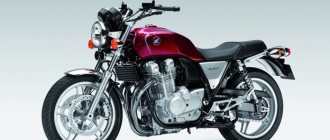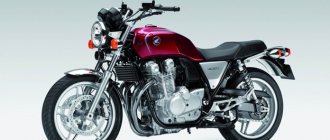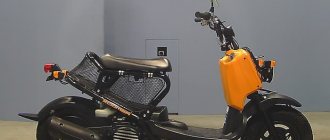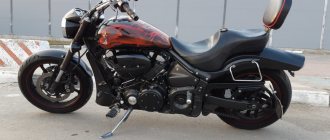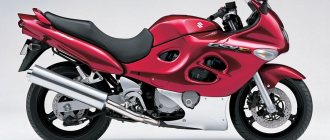Design
Van Vans are the quintessential all-round Japanese motorcycles that were so popular back in the 60s and 70s, with some modern twists to bring them up to date. The V-shaped seat is narrow and relatively low, allowing even very short drivers to reach the ground.
The presence of a push-button starter and fuel injection system, which proves the modernity of the Van Van, reviews of owners find useful, but given the intended use of the motorcycle, they would prefer to have an optional kick start. If you have to travel off-road, it is better to have low-tech options in stock.
The installation height of Van Van's instruments is assessed positively by owners: the readings are easy to read, they are located at a sufficient level so that they can be covered at one glance. Users don't really like having to look down to check sensor readings. The headlights are, as you'd expect, classically round, although perhaps a dual setup would have suited better. The taillight is chunky, probably too big. But it's retro and the bike should look the part.
Chassis
The Suzuki Van Van starts with a diamond-shaped tubular steel frame that uses the engine as one of the structural elements to complete the outline. This not only allowed the engine to be lowered, but also reduced the overall weight of the motorcycle due to the complete elimination of part of the frame. Standard forks support 33mm tubes in front, and a single coil-hydraulic shock absorber is a swingarm at the rear. 5.35-inch rims are mounted on them, however, with a complete lack of customization options.
The spoked aluminum wheels are fitted with balloon tires that are almost comically huge for a motorcycle whose wheel sizes are 130/80-18 at the front and 180/80-14 at the rear. Tires have on-road or off-road profiles to suit a variety of riding conditions.
The brake caliper encloses the front brake disc, and, maintaining the old style, used a mechanical drum to slow the rear wheel. The presence of this retro element in Van Van user reviews for a 128 kg car is called a fairly good option.
Competitors
The Van Van is more or less a mini motocross bike, which is backed up by all its retro styling. Therefore, when choosing alternative options, you should not limit yourself to one appearance. When you consider design goals, engine size and price, its closest rival is Yamaha's TW200.
It’s immediately noticeable that the TW200’s appearance is more cross-country oriented. There's a sort of crossover "fullness" created by the shortened frame on a short 52.2-inch wheelbase, which is shorter than the Van Van's 54.5 inches. Despite its shorter length, the Yamaha has a bench seat height of 31.1 inches, which is almost a full inch taller than the Suzuki's 30.3 inches.
While the Van's 5.35 inches of suspension travel is probably plenty for most riders, the Yamaha takes it up a notch with 5.9 inches of travel in the rear and a whopping 6.3 inches of travel in the front. Both bikes use a rear drum brake in addition to the front hydraulic disc, and both feature spoked wheels with thick, dual-purpose tires that look capable of riding confidently on loose and soft surfaces like sand.
The Yamaha's engine capacity is 3 cubic meters less than that of the Van Van with 199 cubic meters. cm. It is also air-cooled, single cylinder, but has a 28 mm Mikuni carburetor. Some users, without fear of being considered old-fashioned, prefer a carburetor over a fuel injection system for its simplicity. Both bikes have a standard big-bike-derived control system that includes a manual clutch and a five-speed constant mesh gearbox to regulate speed and operating rpm.
The price of these model motorcycles is the same, it is equal to 4599 US dollars, which almost raises suspicions of collusion. In the end, it really comes down to whether you want something that looks like a fairly modern mini-enduro, or something more like a classic DIY motocross bike.
Is there a winner? Users like the Van Van's more comfortable seating position, as the Yamaha's firm seat simply asks the rider to stand on the pegs more than sit.
Transmission
Despite its small size, it retained its retro styling and treated the VanVan like a full-size motorcycle, using a manual transmission and clutch to transfer power to the rear wheel. It might be tempting to fit some sort of scooter-style CVT, but since the vehicle comes with the usual manual setup, it certainly qualifies as a good trainer bike. What distinguishes this motorcycle from the Suzuki 125 is the transmission. The fact is that the latter has a six-speed gearbox. But the Van Van 200 has five stages.
Motor
The choice of engine also contributed to the reduction in overall weight. Nothing says simplicity like air cooling, and that's exactly what we have here. Single-cylinder, four-stroke, 199 cc engine. cm has a single cam head to control valve timing. Instead of relying on cooling radiators, the manufacturer added an oil cooler as an additional layer of engine protection.
Not everything is so simple with induction control. An electronic fuel injection system measures air-to-fuel ratios for economy and emissions control, while Suzuki's Auto Idle Speed Control facilitates cold starts and stabilizes idling without driver intervention. The catalyst in the exhaust system burns everything that comes out of the combustion chamber. Drivers' reviews are sympathetic to the lack of a carburetor in Van Van. Its presence would simplify the design, but would make it more difficult to meet emission standards for on-road driving.
Lightweight sandbike
Recently reintroduced in the US, the Van Van features a 200cc engine. cm – a significant increase compared to the previous 125 cc. cm. A typical motocross motorcycle, it is designed to be ridden on both dirt and gravel roads and over rough terrain, and the wide rear tire qualifies it as a sand bike.
Lightweight and capable, the VanVan 200 is superior to an ATV in some situations, ideal for cruising around the ranch, quickly checking traps, or cruising along the beach - anywhere the ground is so loose that four wheels will immediately get stuck in it.
